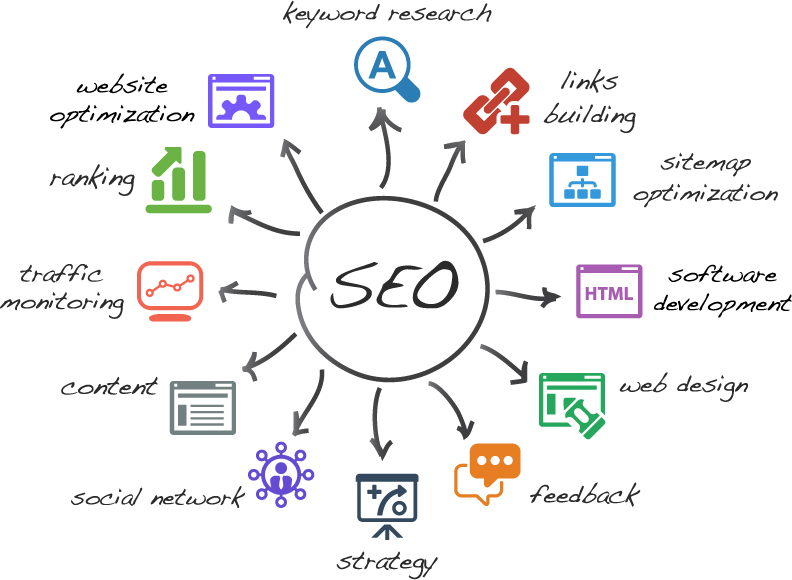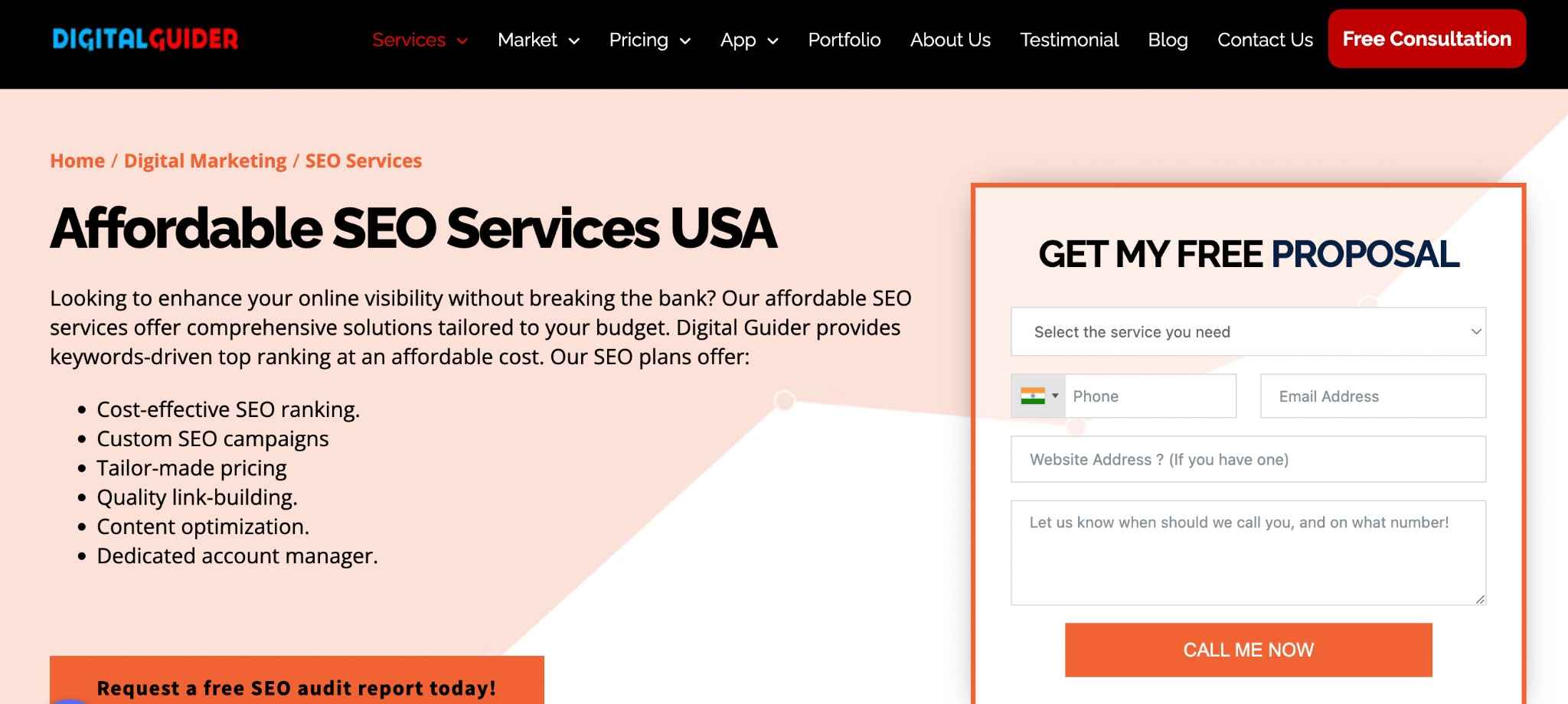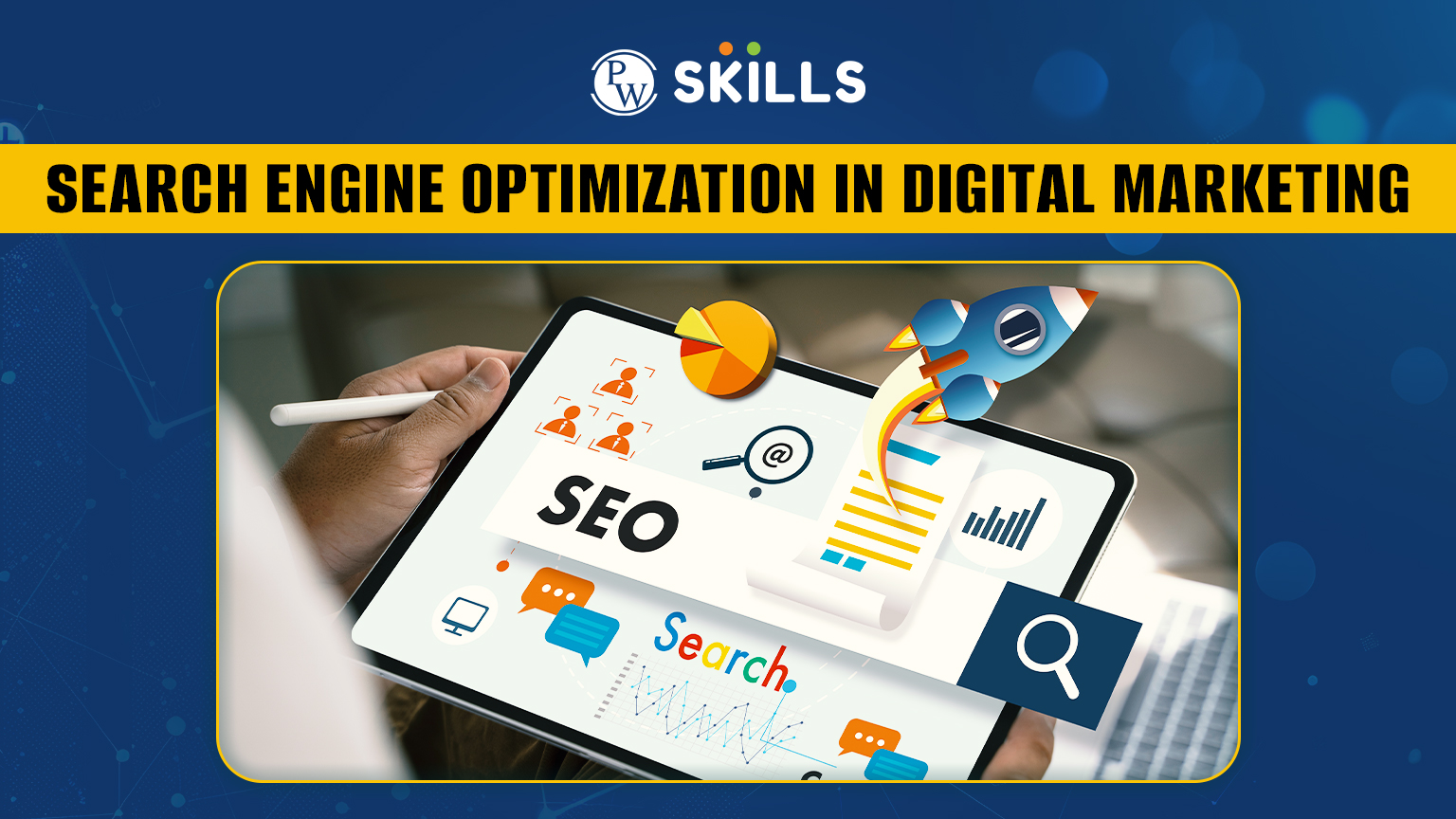SEO Optimization: A Comprehensive Guide for Enhancing Website Visibility
In the ever-evolving digital landscape, your website is like a ship setting sail in a vast, competitive ocean. To navigate the treacherous waters of search engine results pages (SERPs) and reach your desired destination – increased visibility and organic traffic – you need a trusty compass: SEO optimization. This comprehensive guide will equip you with the knowledge and strategies to steer your website towards the top of the search rankings.
Understanding the Building Blocks of SEO
SEO optimization is like a multi-faceted Rubik’s Cube, with each side representing a crucial aspect. Let’s delve into the key elements that make up this puzzle:
**Keywords:** These are the words or phrases that potential visitors type into search engines to find information related to your website. It’s like giving Google a treasure map to help it find the hidden gems on your site that align with users’ queries.
**Content:** Your website’s content is the heart and soul of your SEO strategy. Original, high-quality, and keyword-rich content captivates your audience, earning their favor and Google’s respect. Remember, substance over fluff is always the way to go.
**Backlinks:** Think of backlinks as votes of confidence from other websites. When reputable sites link to your content, it’s like they’re giving you a nod of approval. Google takes these endorsements seriously, boosting your website’s credibility and search ranking.
**Technical SEO:** This covers the behind-the-scenes elements that make your website search engine-friendly. From website speed to mobile optimization, every aspect matters. It’s like fine-tuning your engine to ensure a smooth and efficient ride through the SERPs.
**Local SEO:** If your business has a physical location, local SEO ensures that your website appears prominently in search results for nearby searches. It’s like adding a local flavor to your SEO strategy, helping your business stand out in your community.
SEO Optimization: A Guide to Website Visibility
In the ever-evolving digital landscape, SEO optimization has become indispensable for businesses seeking to establish a strong online presence. It’s like building a digital billboard that catches the attention of potential customers searching for products or services related to your business. By employing SEO techniques, you can elevate your website’s ranking in search engine results pages (SERPs), boosting your visibility and attracting more traffic to your site.
Keywords: The Building Blocks of SEO
At the heart of SEO optimization lies the identification of relevant keywords. These are the terms and phrases that users type into search engines to find information. By incorporating these keywords into your website’s content, you increase the likelihood that your site will appear in the search results for those terms. It’s akin to using the right bait to catch the attention of your target audience.
Selecting the most effective keywords involves careful research and understanding of your audience’s search habits. Use tools like Google Keyword Planner to identify keywords with high search volume and low competition. Focus on long-tail keywords, which are more specific and less competitive than general keywords. By targeting these long-tail keywords, you can attract users with more specific needs, increasing the likelihood of conversions.
Once you’ve identified your keywords, weave them seamlessly into your website’s content in a natural and informative manner. Don’t stuff keywords into your content; instead, use them strategically in headlines, subheadings, page titles, and throughout the body of your text. Think of it as planting breadcrumbs that lead search engines directly to your website.
Additional SEO Strategies
In addition to keyword optimization, there are numerous other SEO strategies that can enhance your website’s visibility and performance. These include:
- Optimizing Page Speed: Ensure your website loads quickly to provide a seamless user experience. Search engines favor fast-loading websites.
- Mobile-Friendliness: Make sure your website is responsive and adjusts to different screen sizes. Mobile browsing is now the norm, so optimizing for mobile devices is essential.
- Building Backlinks: High-quality backlinks from reputable websites serve as votes of confidence for your website, boosting its credibility and authority in the eyes of search engines.
- Local SEO: If your business has a physical location, optimize your website for local search results to connect with customers in your area.
- Regular Content Updates: Fresh and relevant content keeps your website active and engaging for both users and search engines. Regularly publish new blog posts, articles, and other content to signal to search engines that your website is up-to-date and valuable.
SEO Optimization: A Guide to Ranking Higher in Google Search
In the cutthroat world of online marketing, search engine optimization (SEO) reigns supreme as the key to unlocking greater visibility and attracting a steady stream of potential customers. By optimizing your website’s content, structure, and off-page presence, you can increase your chances of appearing higher in Google search results and reaping the rewards that come with it.
On-Page Optimization
On-page optimization focuses on improving your website’s elements that you have direct control over. This includes optimizing your page titles, meta descriptions, header tags, and content for relevant keywords. By using keywords strategically throughout your site, you make it easier for Google to understand what your website is about and rank it accordingly.
Off-Page Optimization
Off-page optimization refers to strategies that take place outside your website. Building high-quality backlinks from reputable sources is crucial in establishing your website’s credibility and authority. By securing backlinks from websites in your industry or related niches, you can signal to Google that your site is a valuable resource that others deem worthy of referencing.
Social Media Marketing
Social media marketing plays a significant role in off-page optimization. Active engagement on platforms like Facebook, Twitter, and LinkedIn can help you connect with potential customers, share valuable content, and build relationships. By regularly posting engaging content and interacting with followers, you can increase your brand’s visibility and drive traffic to your website.
Technical SEO
Technical SEO encompasses a range of behind-the-scenes factors that affect your website’s performance and rankings. This includes optimizing your website’s speed, mobile responsiveness, and security. By ensuring that your website loads quickly, adapts seamlessly to different devices, and is secure from potential threats, you can improve the user experience and enhance your chances of ranking higher.
Local SEO
Local SEO is essential for businesses that serve a specific geographic area. By optimizing your website for local search terms and building local citations, you can make it easier for potential customers in your neighborhood to find and contact you. This is particularly crucial for brick-and-mortar businesses that rely on local foot traffic.
**SEO Optimization: A Comprehensive Guide to Achieving Search Engine Success**
In the cutthroat world of digital marketing, standing out amidst a sea of competitors requires a strategic approach. Search engine optimization (SEO) has emerged as the beacon that guides businesses toward the summit of search engine rankings, driving organic traffic and bolstering brand visibility.
**What is SEO Optimization?**
SEO optimization is the art of fine-tuning your website to make it more search engine-friendly. By optimizing various aspects of your website, such as its content, structure, and technical setup, you can improve your chances of appearing higher in search results pages. Search engines like Google use sophisticated algorithms to rank websites based on their relevance, authority, and user experience. By understanding how these algorithms work, you can optimize your website to meet their criteria and enhance your visibility to potential customers.
**Technical SEO: The Foundation of Success**
The foundation of effective SEO lies in optimizing your website’s technical aspects. This involves ensuring your website’s structure is logical and easy to navigate, its speed is lightning-fast, and its content is accessible to both search engines and users alike. Search engines rely on crawlers to scour the web, indexing your website’s pages so they can be displayed in search results. A well-optimized website makes it easier for crawlers to understand your content and index your pages efficiently, increasing your chances of ranking higher.
**1. Website Structure: The Blueprint of Your Site**
The structure of your website is akin to the blueprint of a house. It determines how users and crawlers navigate your site and find the information they seek. A well-organized website with a clear hierarchy and intuitive navigation menus makes it easier for both parties to explore your content. This structure also helps search engines understand the relationship between different pages on your website, improving your chances of ranking for relevant keywords.
**2. Website Speed: The Race Against Time**
In today’s fast-paced digital world, patience is a scarce commodity. If your website takes an eternity to load, chances are high that potential customers will abandon ship and head to a competitor’s site in an instant. Google and other search engines prioritize websites that load quickly, recognizing that it enhances the user experience. Optimizing your website’s images, minifying code, and implementing caching techniques can significantly improve your website’s loading speed and give you an edge in the race for visibility.
**3. Website Accessibility: Inclusion at Its Core**
Accessibility is not just a buzzword; it’s a fundamental aspect of SEO optimization that ensures your website is inclusive and accessible to all. Search engines like Google actively promote websites that are optimized for people with disabilities, including those with visual, auditory, or cognitive impairments. By utilizing accessibility features such as alt text for images, appropriate color contrast, and keyboard navigation, you can create a welcoming and accessible digital space for all visitors.
**4. Mobile Optimization: Catering to the On-the-Go Generation**
With the proliferation of smartphones and tablets, mobile optimization has become paramount in SEO. Search engines prioritize websites that provide a seamless user experience on mobile devices. This includes ensuring your website is responsive, adjusting to different screen sizes, and providing easy-to-navigate menus and content formats. By optimizing your website for mobile, you can cater to the growing number of users who access the web from their handheld devices.
**5. Security and Trust: Building a Foundation of Confidence**
Security is not an afterthought in SEO optimization; it’s an essential pillar that builds trust with both users and search engines alike. Google and other search engines favor websites that employ secure protocols such as HTTPS, which encrypts communication between the user’s browser and the website’s server. By implementing SSL certificates and employing best practices to protect user data, you can create a secure and trustworthy environment that boosts your website’s reputation and improves your search engine rankings.
**SEO Optimization: The Ultimate Guide to Mastering Search Engine Rankings**
If you’re a website owner, you know how cutthroat the online world can be. In this digital jungle, visibility is everything, and SEO optimization is the key to reigning supreme in search engine rankings. For those of you who don’t know, SEO stands for Search Engine Optimization, and it’s the art of tweaking and tuning your website to make it more appealing to Google’s ever-watchful algorithms.
**Crafting Compelling Content**
Content is king, and nowhere is that more true than in the realm of SEO. Google loves fresh, unique, and engaging content that satisfies users’ search queries. Treat your website like a buffet, offering a diverse spread of articles, blog posts, videos, and infographics that cater to your audience’s appetites. Remember, substance trumps fluff every time.
**Technical Optimization: Digging into the Details**
Behind the scenes, your website’s technical underpinnings can make or break your SEO efforts. Ensure your site loads lightning-fast, is easily navigable, and works flawlessly on any device. Optimize images, use descriptive titles and meta tags, and structure your content logically. These technicalities may seem like small potatoes, but they’re the foundation for a search-engine-friendly website.
**Keyword Research: Unlocking the Search Engine Secrets**
Think of keywords as the magic words that open the door to user searches. Research popular and relevant keywords that align with your content and target audience. Use keyword-rich phrases throughout your website, including in headlines, subheadings, and body text. Just don’t go overboard with the stuffing, or Google will penalize you.
**Building Backlinks: The Power of Popularity**
In the online world, popularity is a priceless currency, and backlinks are the gold standard. When authoritative websites link back to yours, it’s like a vote of confidence that boosts your SEO credibility. Reach out to influencers, partner with other businesses, and create shareable content that attracts links like moths to a flame.
**Monitoring and Analysis: Measuring Success and Identifying Opportunities**
Tracking website performance through analytics tools helps identify areas for improvement and monitor progress. Google Analytics and other tools provide a wealth of data that reveals user behavior, traffic sources, and keyword performance. Use this information to fine-tune your SEO strategy and stay ahead of the competition.
SEO Optimization: A Comprehensive Guide
We live in the digital age, where having an online presence is crucial for businesses to thrive. Search engine optimization (SEO) is the key to unlocking the potential of your website, ensuring it ranks high in search results and attracts more visitors. By following a comprehensive SEO strategy, businesses can significantly improve their visibility, organic traffic, and ultimately drive more sales.
Keyword Research
The foundation of SEO is keyword research. Identifying the right keywords that potential customers are searching for is essential. Use tools like Google Keyword Planner or SEMrush to analyze search volume, competition, and related keywords. Focus on long-tail keywords, which are more specific and less competitive. Remember, it’s about finding the sweet spot between relevance and search demand.
Content Creation
Content is king, but not just any content will do. Create high-quality, informative, and engaging content that aligns with your targeted keywords. Structure your content using headings, subheadings, and bullet points to enhance readability. Make sure your content is optimized for both search engines and human readers. By providing valuable information, you build trust and authority with your audience.
Technical SEO
Technical SEO involves optimizing your website’s infrastructure to improve its crawling and indexing by search engines. Ensure your website is mobile-friendly, loads quickly, and has a clean and organized URL structure. Implement structured data to help search engines understand the content on your pages. A well-optimized technical framework ensures your website is accessible and search engine-friendly.
On-Page Optimization
On-page optimization focuses on elements within your website that directly affect its ranking. Include your target keywords in page titles, headings, meta descriptions, and throughout the content. Use internal linking to connect related pages and distribute link equity. Optimize images with relevant alt tags to provide context to search engines. By paying attention to on-page optimization, you help search engines understand the relevance and structure of your website.
Link Building
Building backlinks from high-quality websites is like getting votes of confidence for your website. Reach out to industry influencers, submit guest posts to relevant blogs, and participate in online communities. Focus on acquiring backlinks from websites with high domain authority and relevance to your niche. Remember, it’s not just about the quantity of backlinks, but also the quality and diversity of the sources.
Local SEO
If your business serves a specific geographic area, local SEO is crucial. Create a Google Business Profile, optimize your website for local keywords, and encourage customer reviews. Local SEO helps your business appear in local search results, maps, and other localized listings, making it easier for customers in your area to find you.
Social Media
Social media is an integral part of SEO, although it doesn’t directly impact rankings. By sharing valuable content, engaging with your audience, and building relationships on social platforms, you can increase brand awareness, drive traffic to your website, and establish your business as an industry thought leader. Social media is a powerful tool for connecting with your target audience and amplifying your SEO efforts.
Conclusion
By following these comprehensive SEO optimization techniques, websites can significantly improve their ranking, visibility, and organic traffic. SEO is a continuous process that requires ongoing effort and monitoring. Stay up-to-date with the latest SEO trends, track your results, and make adjustments as needed. By investing in a robust SEO strategy, businesses can unlock their full online potential and reap the rewards of increased website traffic, leads, and sales.
Saran Video Seputar : seo optimization




Leave a Reply